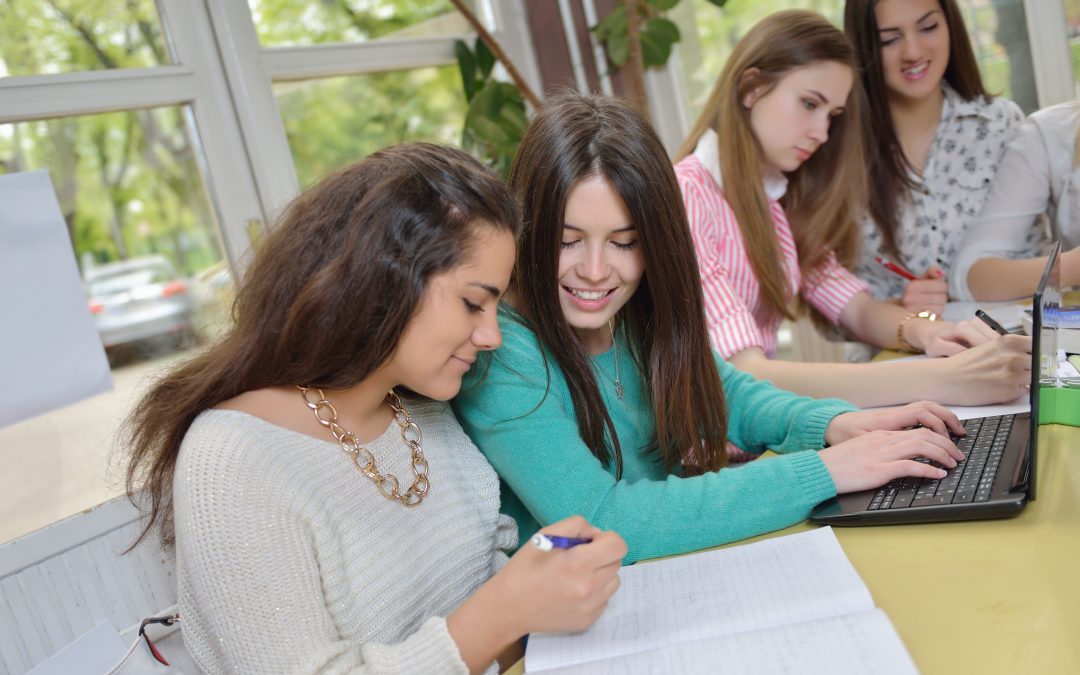
by Kim Loomis | Jan 7, 2020 | Blended Learning, Digital Learning Models, Online Learning, Personalized Learning, Program Design, Research, Uncategorized
When students struggle in the traditional classroom and absences become daunting, creating larger and deeper learning gaps, where can educators turn? One way to help struggling students is by providing opportunities for success in different learning environments. Past practices often led students away from neighborhood schools, to alternative placement educational facilities. Yet, not all students that struggle need such a drastic remedy. Access to digital curriculum in a comprehensive school setting can be an excellent way to create opportunities to thrive. Digital curriculum is the first piece of the CIA of Blended Learning (digital Curriculum, guided Instruction, authentic Assessment), yet it’s important to ensure that educators understand the partnership between digital content and teacher-led guided instruction. Otherwise establishments create digital learning environments that isolate and remove high quality instructional practices, such as teacher and peer interaction, plus they tend to lower standards/expectations. This is often seen in credit recovery programs across the nation, as documented by Nat Malkus in his whitepaper Second Chance or Second Track (September 2018), were second chance credit recovery becomes a lower-level pathway of isolated, independent study programs designed for struggling learners. When we lower expectations, we are creating a lower track of students, many of whom were struggling to begin with. The TNTP whitepaper Opportunity Myth (2018) notes how schools and teachers are letting students down with low level learning opportunities that just don’t meet the standards. Yet, we must cultivate classrooms where struggling students learn how to take ownership of their learning. Where students can track and manage their learning outcomes in a digital platform, that allows them to pick up where they...

by Kim Loomis | Jul 10, 2019 | Blended Learning, Digital Learning Models, Online Learning
Clay Christensen writes of the Theory of Jobs to Be Done, “When we buy a product, we essentially ‘hire’ something to get a job done… People don’t simply buy products or services, they ‘hire’ them to make progress in specific circumstances.” Understanding the “job” for which one is hiring for will benefit the client in selecting the right product and service in need and maximize its fullest potential. When developing a digital learning program, it’s key to align our true priorities with the proper product and service. Just as important, is to ensure appropriate staff professional development when changing classroom pedagogy. Using online content and tools has become a regular appearance in the nation’s K-12 classrooms. Many different deployment methods have been utilized – often lumped into a single category of ‘digital learning.’ However, in the landscape of the classroom, when technologies are brought into the fold, not all programs are created equal. Especially in the eyes of the ever watchful National Collegiate Athletic Association (NCAA), who is concerned when schools develop non-traditional learning programs. Thus it is important to note the various types and degrees of digital learning environments that are being offered to students. The table below attempts to describe the various digital learning deployment programs, in degrees from non-traditional fully online learning, to the traditional classroom’s utilization of digital content (e.g. content area instruction) and tools (e.g. productivity software and apps) to enhance student success and engagement. What is your digital learning vision? What deployment program best describes the ‘job to be done?’ Knowing the answers to these questions will help you seek the best products...

by Kim Loomis | Aug 27, 2018 | Blended Learning, Digital Learning Models, Program Design
It’s that time of year again, when students are excited to meet their new teachers and staff are busy preparing classrooms. It’s important to kick the school year off on the right foot. One that can lead to excitement, innovation, and higher student gains. As the saying goes, “We can’t keep doing the same thing, and expect different results.” It’s time to consider partnering with digital content. When teachers utilize digital curriculum, it is like having an aide in the classroom – one for each and every student. In the CIA of blended learning model, teachers partner with digital curriculum to help deliver Depth of Knowledge one and two (DoK 1-2). This frees time in the day for the teacher to work differently. They no longer have to provide all content. Classroom teachers need to partner with the digital curriculum and allow it to do what it is best at – creating an individualized learning space for each student. Again, the technology is good only at a low level of understanding, DoK 1-2. Releasing control to another is a big ask, I know. Think about other partnerships you have in your life. Take your spouse or kids for instance. They may not put the dishes in the dishwasher the way you would, but it gets done. They may not fold the clothes the way you might, but again it gets done. Teachers may find that the digital curriculum does not instruct the way they would have, but it will get done. And just like you may walk behind your spouse or kids and rearrange the dishes, or...

by Kim Loomis | Oct 12, 2017 | Blended Learning, Digital Learning Models, Program Design
Think Outside the Box – A new book for Secondary Schools I’ve spent the last year accumulating and assembling program advise and deployment designs for secondary schools into a new book. I’ve gathered these words of wisdom, (nearly twenty years’ worth in the digital learning front) from working with hundreds of schools and thousands of classroom teachers in Nevada’s Clark County School District, the fifth largest in the nation. Below are a few excerpts from my new book titled: Think Outside the Box: The CIA of Blended Learning and 10+ Designs for Secondary Schools. Introduction Having access to digital content creates scenarios that you may have not even considered. Thinking outside the box allows us to see beyond the most obvious. Thinking outside the box opens doors to new prospects. Thinking outside the box forces us to be innovative. That is why this book is titled think outside the box. Boxes come in all sizes; from the student information system in your district, to the four walls of a classroom, or even the socio-economic classification one was raised in. It’s a reminder to all of us that boxes do not define our limitations. Not only will schools of the future need to think outside the box, they must think differently about the relationships of curriculum, instruction, and assessment (CIA). In blended and personalized learning, that’s: Digital Curriculum Guided Instruction Authentic Assessment Part 1 – Foundations of Blended I believe the power of technology lies in digital curriculum. It has the potential to open the doors to a brighter future, help fill gaps, and provide more time...

by Kim Loomis | Aug 27, 2017 | Blended Learning, Digital Learning Models, Program Design
School is in (or just about to begin). Now is an appropriate time of the year to reflect on your desires and dreams for digital learning. It starts with a goal. Knowing where you want to be in five years. Casting a vision for the future. Working toward that goal each day. Success will come with challenging work, learning from failures, and the tenacity of your team to accomplish the dream. Earlier this month, I had the pleasure to share Clark County’s path of success in a recent podcast, hosted by Michigan Virtual Learning Research Institute (MVLRI). Listen to the 30 minute Podcast #40 August is a wonderful time of the year. The new school year is upon us. The energy level is high. Excitement fills the air from parents, students, and teachers. How will you capitalize upon this? Who can you reach out to support your dreams and desires? I’ve been at five different schools in the last two weeks, from traditional comprehensive, alternative education, and specialty schools for adjudicated youth, plus helping with a brand-new school opening this year targeting students overcoming the chains of addition. It’s an exciting time for digital learning. More schools are thinking outside the box when it comes to the possibilities of online courseware. Well beyond just credit recovery! When I think back to the how this all started, I’m taken to the humble beginnings in Clark County School District, with a goal of one-third of all students in an online or blended learning environment. The steps we took to meet this goal started with teacher professional development, followed with access to...

by Kim Loomis | Feb 26, 2017 | Blended Learning, Digital Learning Models, Program Design
When you think of the words “blended learning” what image comes to mind? I ask this because blended learning models are not just one thing. It’s like the words, “vehicle” or “home.” You have a mental image of a vehicle and a home, but your mental image is probably not the same as the person next to you. Vehicles and homes come in many different shapes, sizes, colors and prices. A pickup truck, compact automobile, and luxury sports car are all very different vehicles. As are a two-story, ranch, and apartment homes. Sadly, for some of our students their vehicle is home. Blended learning, like vehicles and homes, come in many different formats. Some are just a few small steps outside the traditional setting, others are very large leaps away from what one would consider a traditional classroom. And like the varying prices of vehicles and homes, the price or mind shift change in pedagogy and structures of the blended classroom or school can be low or steep. Blended learning is not just one thing. It’s underpinning, like the four wheels of a vehicle or the foundation of a home are described in the definition: combining online digital curriculum with traditional classroom instructional methods, but each deployment model, just like vehicles and homes, will look and feel very different when filled with students and teachers. Like the varying prices of vehicles and home there is a cost, or “purchase” price of the adoption of each type of blended learning model. As you consider blended learning adoption, think about what structural changes your classroom, school, or district would...








Recent Comments